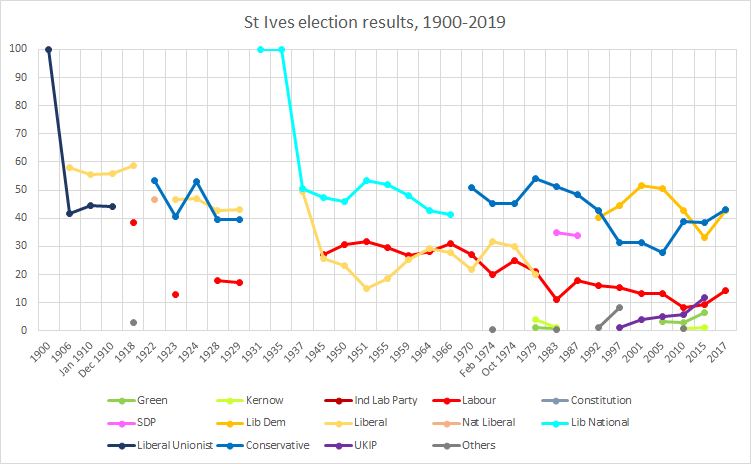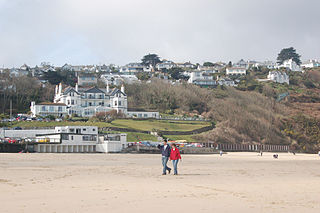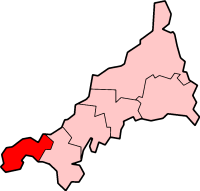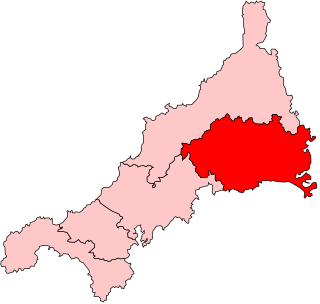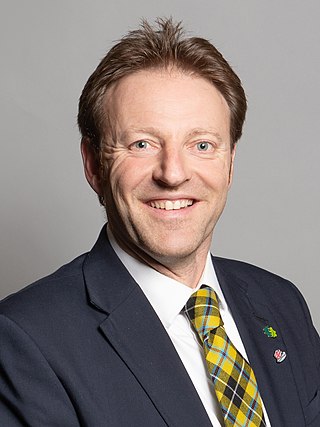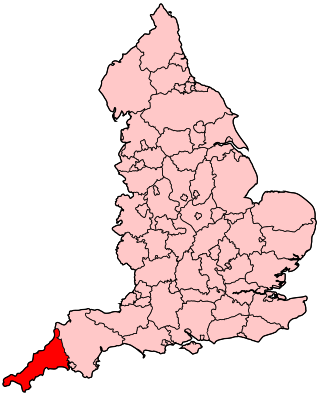St Ives has elected MPs to every Parliament since 1558, except for a brief period during the Protectorate. It was originally a mere parliamentary borough that returned two MPs until the Great Reform Act of 1832, when its representation was cut to a single member. In 1885 the borough was abolished, but the St Ives name was transferred to the surrounding county constituency.
St Ives borough
The borough established under Queen Mary consisted of the parish of St Ives in western Cornwall, a seaport and market town in which the main economic interests were fishing and the export of ores mined nearby. In 1831, the population of the borough was 4,776, and contained 1,002 houses.
The franchise was initially restricted to the town corporation, but after a judgment in a disputed election in 1702 the right to vote was given to all inhabitants paying scot and lot; in the early 19th century this amounted to a little over 300 voters. This was a wide franchise for the period, and its reasonable size meant that St Ives was one of the few Cornish boroughs that could claim not to be rotten.
Elections were usually contested. Local wealthiest families were able to exercise considerable influence on the outcome yet none was predominant. The result could rarely be taken for granted and it was necessary to court the voters assiduously. From the 17th century were three such families from the first: the Hobart family, [n 3] the Praeds (at the time of Treventhoe manor), and the Dukes of Bolton (the Paulet family) [n 4] – to which added by the mid 18th century the Stephens family. In 1751, however, John Stephens, who had previously allied himself with the Earl of Buckinghamshire (a Hobart) and managed the borough's elections on his behalf, "struck out on his own account" (defected independently) and secured the election of his son. Later in the decade Stephens and the Earl once more began to work together, but were unable to prevent Humphrey Mackworth Praed from establishing sufficient influence to sway one of the two seats.
By 1761 alliances coalesced, the Earl and Praed on one side nominating candidates against Stephens and the Duke of Bolton on the other. The by-election in 1763, when Buckinghamshire's brother-in-law Charles Hotham was re-elected after being appointed to a position in the Royal Household, cost the Earl £1,175 including 7 guineas each to 124 people, resulting in an uncontested election. [n 5]
There was a further bitterly contested election in 1774: allegations of bribery were investigated by a House of Commons committee, whose proceedings are recounted at length by the contemporary historian of electoral abuses, Thomas Oldfield. [n 6] Samuel Stephens, defeated by 7 votes, accused William Praed and Adam Drummond (the Duke of Bolton's candidate) of benefiting from several types of corruption. Humphrey Mackworth Praed, William's father, was said to have lent large sums to voters on the understanding that repayment would not be demanded if they voted for Praed and Drummond; but opposing counsel adduced evidence that Stephens had also resorted to bribery. However, it was alleged that many of Stephens' supporters had been prevented from voting, by rating them as not liable for scot and lot and so not eligible to vote; this disenfranchisement was a frequent abuse in such boroughs. His side, as petitioners, failed to bring any evidence of criminal misconduct by the parish overseers so the committee decided they had no jurisdiction to interfere. In the end, the committee upheld Drummond's election and declared that neither Stephens nor Praed had been properly elected, thus a writ was issued for a by-election to fill the second seat.
The cost of electioneering in St Ives seems eventually to have led to Buckinghamshire and Bolton withdrawing, and by 1784 Praed was considered unchallenged as patron. Nevertheless, Stephens' influence was not extinguished, and it was recorded that the patrons at the time of the Reform Act were Samuel Stephens of Tregarron and Sir Christopher Hawkins of Trewithan (who had purchased the manor of Mr Praed).
The Reform Act extended the boundaries, bringing in the neighbouring parishes of Lelant and Towednack and reduced the two St Ives seats to one. A new high of 584 voters qualified at the first reformed election, that of 1832.
On extension of the franchise in 1868 of the "second Reform Act", the electorate never passed 1,500, and had fallen to barely 1,000 by the Redistribution of Seats Act 1885, the cornerstone of the third reform legislation, under which the "borough" for its parliamentary definition was abolished that year, the area becoming contributory to a larger county division.
St Ives county constituency
- 1885–1918
Division of counties into single-member constituencies was effected in 1885: Cornwall having six. The westernmost of these, in which St Ives stood, was formally The Western or St Ives Division of Cornwall but was most often referred to simply as St Ives or as West Cornwall.
This area included Penzance, Paul, Ludgvan and St Just, and stretched not only from Land's End to St Erth but also included the Isles of Scilly. This duchy seat was abnormally low in owner-occupiers, with many "nonconformist" Christians [4] and the Conservatives were consequently very weak. However, local sentiment was strongly against Irish Home Rule or independence, seen as a particular threat to the livelihood of the fishermen and other maritime employees who made up much of the electorate, and St Ives therefore became a Liberal Unionist stronghold from 1886. [n 7]
- 1918–1983
After the boundary revisions introduced at the general election of 1918, which brought in most of the villages on the Lizard Peninsula (though not Helston), the constituency was simply called Cornwall, St Ives. It underwent further boundary changes in 1950, bringing Helston into the constituency, and in 1983, when it was extended to include all of the Penwith local government district.
The character of the constituency was little changed any of these revisions, but party loyalties may have been disrupted by the 1918 changes. Labour put up a candidate for the first time in 1918, and took more than a third of the vote; at the next election, with Labour withdrawing and the Irish issue no longer able to help Cory, a Conservative was elected for the first time. For the next decade St Ives was a Conservative-Liberal marginal, changing hands four times in the 1920s. However, the formal split of National Liberals from the Liberals offered a popular compromise which suited the voters, so much so as to be a safe seat, and later for Conservatives when the National Liberals finally merged with them in the 1960s, until the formation of the Liberal Democrats re-invigorated the competition in the 1990s. Andrew George captured the seat after the retirement of the sitting Conservative MP in 1997, and took over half the vote in both 2001 and 2005.



